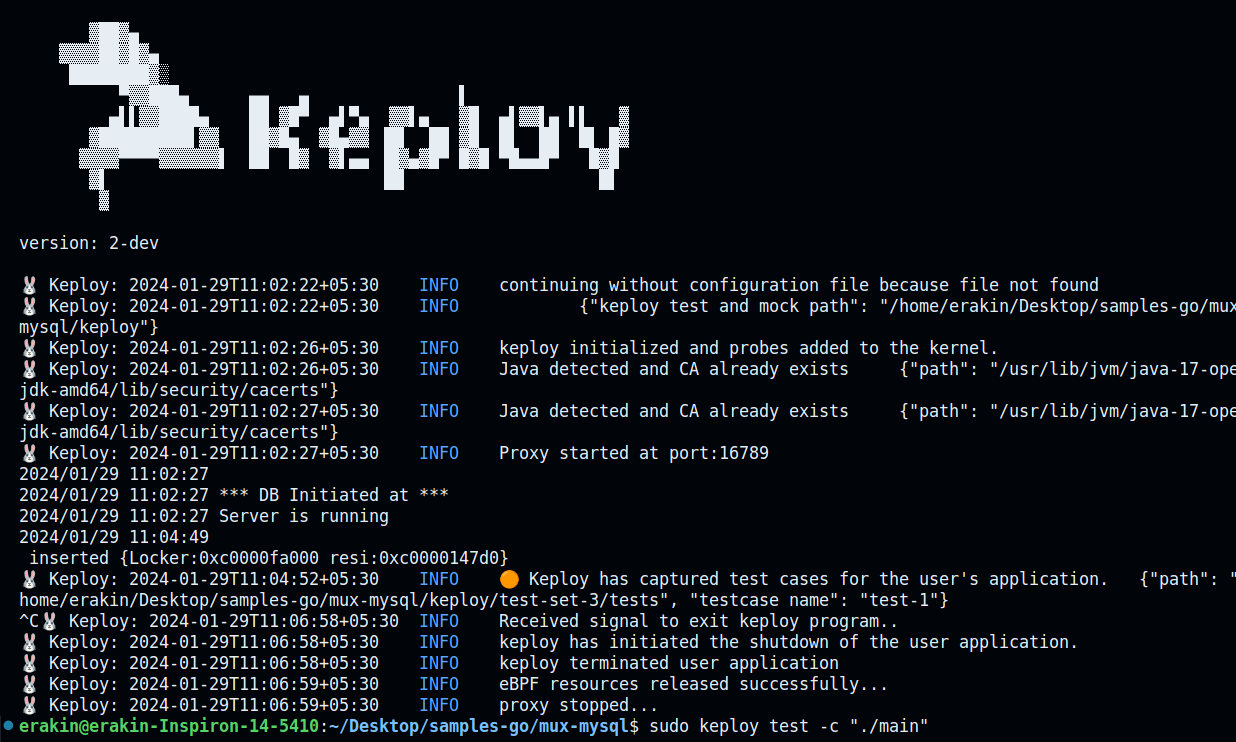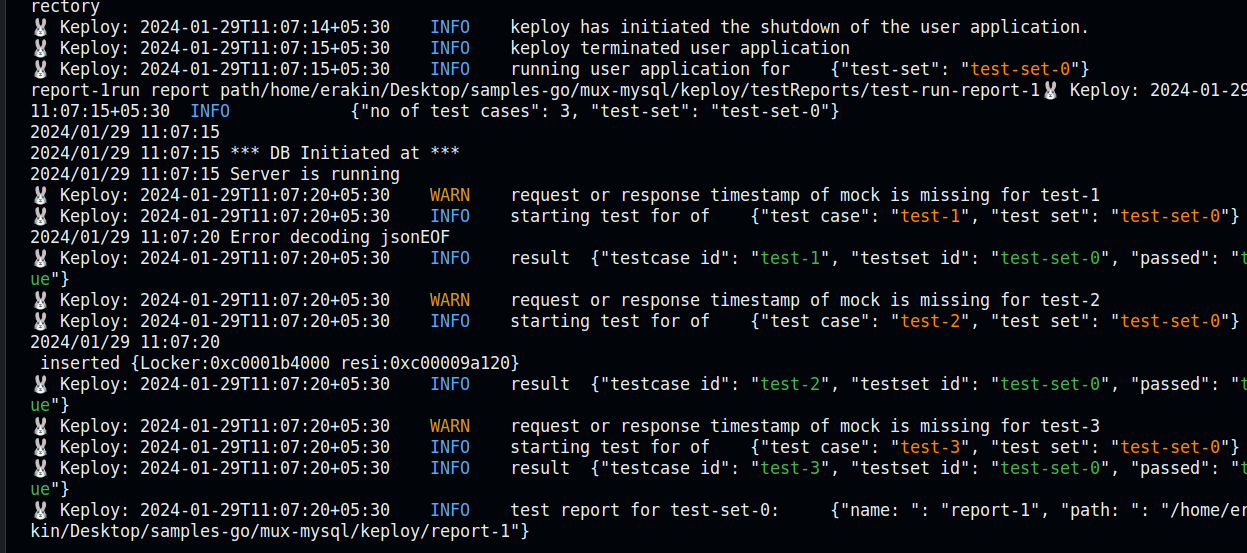Mux MySQL Sample Application
Introduction
A sample url shortener app to test Keploy integration capabilities using Mux and MySQL. Buckle up, it's gonna be a fun ride! 🎢
🛠️ Platform-Specific Requirements for Keploy
Below is a table summarizing the tools needed for both native and Docker installations of Keploy on MacOS, Windows, and Linux:
| Operating System | Without Docker | Docker Installation | Prerequisites |
|---|---|---|---|
| - Docker Desktop version must be 4.25.2 or above - For running Keploy on MacOS natively, refer to Guide | |||
- Use WSL wsl --install - Windows 10 version 2004 and higher (Build 19041 and higher) or Windows 11 | |||
| Linux kernel 5.15 or higher |
On MacOS and Windows, additional tools are required for Keploy due to the lack of native eBPF support.
Keploy Installation
Quick Installation Using CLI
Let's get started by setting up the Keploy alias with this command:
curl --silent -O -L https://keploy.io/install.sh && source install.sh
You should see something like this:
▓██▓▄
▓▓▓▓██▓█▓▄
████████▓▒
▀▓▓███▄ ▄▄ ▄ ▌
▄▌▌▓▓████▄ ██ ▓█▀ ▄▌▀▄ ▓▓▌▄ ▓█ ▄▌▓▓▌▄ ▌▌ ▓
▓█████████▌▓▓ ██▓█▄ ▓█▄▓▓ ▐█▌ ██ ▓█ █▌ ██ █▌ █▓
▓▓▓▓▀▀▀▀▓▓▓▓▓▓▌ ██ █▓ ▓▌▄▄ ▐█▓▄▓█▀ █▓█ ▀█▄▄█▀ █▓█
▓▌ ▐█▌ █▌
▓
Keploy CLI
Available Commands:
example Example to record and test via keploy
config --generate generate the keploy configuration file
record record the keploy testcases from the API calls
test run the recorded testcases and execute assertions
update Update Keploy
Flags:
--debug Run in debug mode
-h, --help help for keploy
-v, --version version for keploy
Use "keploy [command] --help" for more information about a command.
🎉 Wohoo! You are all set to use Keploy.
Other Installation Methods
Install using Docker
Downloading and running Keploy in Docker
On macOS
Note : Keploy is not supported natively on MacOS, so you can follow the below method to run with docker
-
Open up a terminal window.
-
Create a bridge network in Docker using the following docker network create command:
docker network create keploy-network
- Run the following command to start the Keploy container:
alias keploy="docker run --name keploy-v2 -p 16789:16789 --network keploy-network --privileged --pid=host -v $(pwd):$(pwd) -w $(pwd) -v /sys/fs/cgroup:/sys/fs/cgroup -v /sys/kernel/debug:/sys/kernel/debug -v /sys/fs/bpf:/sys/fs/bpf -v /var/run/docker.sock:/var/run/docker.sock --rm ghcr.io/keploy/keploy"
Downloading and running Keploy in Native
Downloading and running Keploy in Native
Prequisites:
- Linux Kernel version 5.15 or higher
- Run
uname -ato verify the system architecture. - In case of Windows, use WSL with Ubuntu 20.04 LTS or higher.
Downloading and running Keploy On WSL/Linux AMD
On WSL/Linux AMD
- Open the terminal Session.
- Run the following command to download and install Keploy:
curl --silent --location "https://github.com/keploy/keploy/releases/latest/download/keploy_linux_amd64.tar.gz" | tar xz --overwrite -C /tmp
sudo mkdir -p /usr/local/bin && sudo mv /tmp/keploy /usr/local/bin/keploy
On WSL/Linux ARM
- Open the terminal Session
- Run the following command to download and install Keploy:
curl --silent --location "https://github.com/keploy/keploy/releases/latest/download/keploy_linux_arm64.tar.gz" | tar xz --overwrite -C /tmp
sudo mkdir -p /usr/local/bin && sudo mv /tmp/keploy /usr/local/bin/keploy
Note: Keploy is not supported on MacOS natively.
Setting up the Docker Desktop for WSL 2
- Install Docker Desktop for Windows from here.
When developing on Windows with Docker Desktop and WSL 2, it's crucial to configure Docker Desktop to allow WSL 2 distributions to access the Docker daemon. This setup enables seamless integration between your Windows environment, WSL 2 Linux distros, and Docker.
By default, Docker Desktop may not be configured to work with all WSL 2 distros out of the box. Proper configuration ensures that you can run Docker commands from within your WSL 2 environment, allowing for a more native Linux development experience while leveraging the power of Windows.
This setup is essential for Keploy to function correctly in a WSL 2 environment, as it needs to interact with the Docker daemon to manage containers and networks effectively. For detailed instructions on how to configure
Docker Desktopfor WSL 2, please refer to the official Docker documentation.
Get Started! 🎬
Clone a sample URL shortener app 🧪
git clone https://github.com/keploy/samples-go.git && cd samples-go/mux-mysql
go mod download
Installation Keploy
There are 2 ways you can run this sample application.
- Using Docker compose : running application as well as MySQL on Docker container
- Using Docker container for MySQL and running application locally
Using Docker Compose 🐳
We will be using Docker compose to run the application as well as MySQL on Docker container.
Start MySQL Instance
docker run -p 3306:3306 --rm --name mysql --network keploy-network -e MYSQL_ROOT_PASSWORD=my-secret-pw -d mysql:latest
Creating Docker Volume
docker volume create --driver local --opt type=debugfs --opt device=debugfs debugfs
Capture the Testcases
Now, we will create the docker image of our application:-
docker build -t url-short .
Once we have our Docker image file ready,this command will start the recording of API calls using ebpf:-
keploy record -c "docker run -p 8080:8080 --name urlshort --rm --network keploy-network url-short:latest"
Make API Calls using Postman or cURL command. Keploy with capture those calls to generate the test-suites containing testcases and data mocks.
Generate testcases
To generate testcases we just need to make some API calls. You can use Postman or simply curl
Generate shortened url
curl --request POST \
--url http://localhost:8080/create \
--header 'content-type: application/json' \
--data '{
"link": "https://github.com"
}'
this will return the shortened url. The ts would automatically be ignored during testing because it'll always be different.
{
"message":"Converted",
"link":"http://localhost:8080/links/1",
"status":true
}
Access all the shortened urls
curl --request GET http://localhost:8080/all
Now both these API calls were captured as editable testcases and written to keploy/tests folder. The keploy directory would also have mocks file that contains all the outputs of MySQL operations. Here's what the folder structure look like:

Now, let's see the magic! ✨💫
Want to see if everything works as expected?
Run the Testcases
Now let's run the test mode (in the echo-sql directory, not the Keploy directory).
keploy test -c "docker run -p 8080:8080 --name urlshort --rm --network keploy-network url-short:latest" --delay 10
output should look like

So no need to setup fake database/apis MySQL or write mocks for them. Keploy automatically mocks them and, The application thinks it's talking to MySQL 😄
Wrapping it up 🎉
Congrats on the journey so far! You've seen Keploy's power, flexed your coding muscles, and had a bit of fun too! Now, go out there and keep exploring, innovating, and creating! Remember, with the right tools and a sprinkle of fun, anything's possible.😊🚀
Happy coding! ✨👩💻👨💻✨
**********************************___**********************************
Running App Locally on Linux/WSL 🐧
We'll be running our sample application right on Linux, but just to make things a tad more thrilling, we'll have the database (MySQL) chill on Docker. Ready? Let's get the party started!🎉
To establish a network for your application using Keploy on Docker, follow these steps. If you're using a docker-compose network, replace keploy-network with your app's
docker_compose_network_namebelow.
Let's start the MySQL Instance
docker run -p 3306:3306 --rm --name mysql -e MYSQL_ROOT_PASSWORD=my-secret-pw -d mysql:latest
Now, we will create the binary of our application:-
export ConnectionString="root:my-secret-pw@tcp(localhost:3306)/mysql"
go build -o main
Capture the Testcases
sudo -E PATH=$PATH keploy record -c "./main"
Generate testcases
To generate testcases we just need to make some API calls. You can use Postman, Hoppscotch, or simply curl
Generate shortened url
curl --request POST \
--url http://localhost:8080/create \
--header 'content-type: application/json' \
--data '{
"link": "https://google.com"
}'
this will return the shortened url.
{
"message": "Converted",
"link": "http://localhost:8080/links/1",
"status": true
}
Redirect to original url from shortened url
curl -request GET localhost:8080/links/1
Now, let's see the magic! 🪄💫
Now both these API calls were captured as a testcase and should be visible on the Keploy CLI. You should be seeing an app named keploy folder with the test cases we just captured and data mocks created
Run the captured testcases
Now that we have our testcase captured, run the test file.
sudo -E PATH=$PATH keploy test -c "./main" --delay 10
So no need to setup dependencies like MySQL, web-go locally or write mocks for your testing.
The application thinks it's talking to MySQL 😄
We will get output something like this:
Wrapping it up 🎉
Congrats on the journey so far! You've seen Keploy's power, flexed your coding muscles, and had a bit of fun too! Now, go out there and keep exploring, innovating, and creating! Remember, with the right tools and a sprinkle of fun, anything's possible.😊🚀
Hope this helps you out, if you still have any questions, reach out to us .
Contact Us
If you have any questions or need help, please feel free to reach out to us at hello@keploy.io or reach out us on

